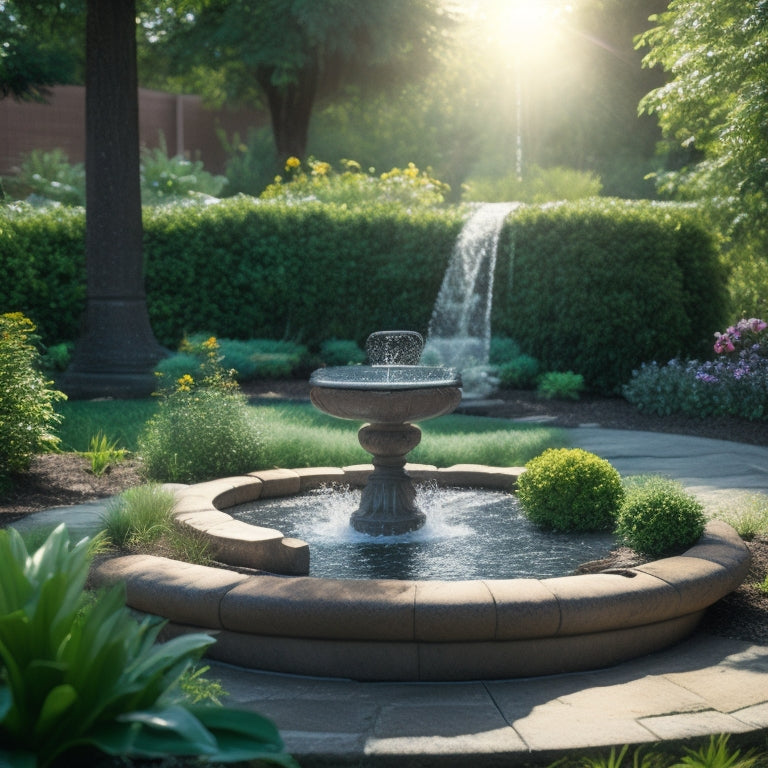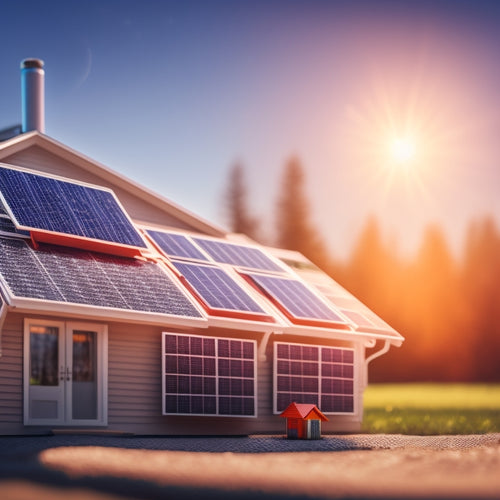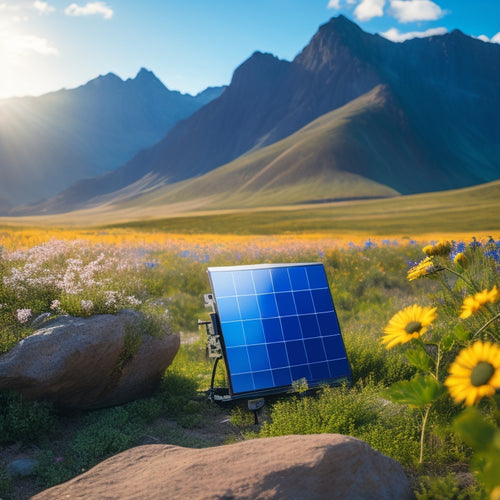
7 Tips for Solar Powered Garden Pumps
Share
You're about to utilize the sun's energy to power your garden's water features, and with these 7 essential tips, you'll be well on your way to designing an efficient and sustainable solar-powered garden pump system. First, choose a solar panel that meets your pump's power requirements, considering wattage, efficiency, and structural soundness. Then, select a pump that matches your garden's water needs, evaluating size, flow rate, and compatibility with your water source. Next, determine your water pressure needs, calculate your solar power requirements, and install your system in a location with direct sunlight. Finally, maintain your system regularly, troubleshoot common issues, and optimize performance - and you'll be ready to unleash the full potential of your solar-powered garden pump system.
Overview
- Evaluate pump size and flow rate to ensure peak performance and efficiency, avoiding energy waste from undersized or oversized pumps.
- Install the solar panel at an angle to maximize sunlight exposure and avoid shading, ensuring optimal energy absorption.
- Regularly inspect and clean the solar panels to remove dirt and debris, maintaining optimal energy generation.
- Choose a pump that matches your garden's water needs, considering total fluid head (TDH) for vertical distance and friction losses.
- Schedule seasonal maintenance to ensure longevity, including inspecting and repairing components, checking battery performance, and draining hoses.
Choosing the Right Solar Panel
When selecting a solar panel for your garden pump, one vital factor to evaluate is the panel's wattage. Confirm it's sufficient to meet your pump's power requirements. A higher wattage panel doesn't always mean better, as it may lead to energy wastage.
Reflect on the panel's efficiency, as it affects the conversion of sunlight to electricity. Look for panels with high efficiency ratings (above 20%) for peak performance.
Additionally, it's important to assess the structural soundness of roofs and regular maintenance to confirm successful installations. Moreover, energy efficiency and green financing options are available for budget-friendly solutions.
During installation, follow these tips: install the panel at an angle to maximize sunlight exposure, avoid shading, and secure it firmly to prevent damage from wind or weather.
Selecting a Suitable Pump Type
You'll need to take into account the pump's size and flow rate to guarantee it can handle your garden's specific needs.
A pump that's too small won't provide enough water pressure, while one that's too large will waste energy.
Accurate system sizing is essential, as it impacts energy efficiency optimization and peak shaving opportunities.
Pump Size Matters
Selecting the right pump size for your solar-powered garden is essential to guarantee peak performance and efficiency.
You'll want to choose a pump that matches your garden's water needs to avoid wasting energy and reducing pump efficiency. A pump that's too small won't provide enough water pressure, while one that's too large will waste energy and increase your costs.
Consider the total fluid head (TDH) of your system, including the vertical distance the water needs to be pumped and the friction losses in the pipes.
It's also important to assess pump efficiency, focusing on flow rate, pressure, and power consumption for optimal operation.
Additionally, verify compatibility of the pump with the water source, such as wells, springs, or rainwater systems.
Pump Flow Rate
As you investigate the world of solar-powered garden pumps, understanding pump flow rate becomes vital for ideal performance.
You'll want to select a pump that can handle the water volume required for your garden's needs. Pump flow rate is measured in gallons per hour (GPH) or liters per hour (LPH). A higher flow rate doesn't always mean better performance, as it can lead to energy waste and decreased pump efficiency.
Instead, focus on flow optimization by choosing a pump that matches your garden's specific requirements. Look for pumps with adjustable flow rates or those designed for specific applications, such as drip irrigation or water features.
Determining Water Pressure Needs
The pump's water pressure needs are critical to ensuring your solar-powered garden pump system functions efficiently.
You need to evaluate the total hydraulic head (TDH) of your system, which is the sum of the vertical lift, friction losses, and pressure required for your desired water feature or irrigation system.
The water source's vertical distance from the pump, as well as the friction losses in the pipes, will impact the TDH.
Additionally, your garden aesthetics will influence the pressure required, such as the height of your fountain or the distance your sprinklers need to reach.
Calculate the TDH accurately to select a pump that can provide the necessary pressure, ensuring your system operates smoothly and efficiently.
Calculating Solar Power Requirements
With your solar-powered garden pump's water pressure needs determined, you're ready to size up the solar power requirements to drive it.
To calculate the required solar power, you'll need to take into account the pump energy consumption. This is typically measured in watts (W) and depends on the pump's flow rate, pressure, and efficiency.
Look for the pump's wattage rating or consult the manufacturer's specifications.
Next, take into account the solar energy efficiency of your solar panel array. This will affect how much power is generated per hour of sunlight.
Installing the Solar Pump System
You've calculated your solar power requirements, now it's time to bring your solar-powered garden pump to life.
Begin by choosing a location for your solar panel that receives direct sunlight, ensuring maximum energy utilization. Install the panel at an angle to optimize energy absorption.
Next, connect the solar panel to the pump's controller, following the manufacturer's instructions.
Then, submerge the pump in your water source, such as a pond or tank. Connect the pump to your garden irrigation system, ensuring a secure and watertight connection.
With your solar pump system installed, you'll start enjoying the benefits of solar-powered garden irrigation, including reduced energy costs and increased water efficiency.
Maintaining Your Solar Pump System
Regular maintenance is key to ensuring your solar pump system operates at peak efficiency and prolongs its lifespan. To maximize system longevity, follow these seasonal maintenance tips:
| Season | Task | Frequency |
|---|---|---|
| Spring | Inspect and clean solar panels | Monthly |
| Summer | Check pump performance and adjust as needed | Bi-Monthly |
| Fall | Drain and store hoses to prevent freezing | Once |
| Winter | Inspect and repair any damaged components | Quarterly |
Troubleshooting Common Issues
You've invested time and effort into setting up your solar powered garden pump, but now you're faced with a problem - it's not working as expected.
You'll need to identify the root cause of the issue, which could be due to a faulty pump or airlock in the system.
Let's walk through the most common problems, starting with a pump that's not working at all, and then address airlock issues that can prevent your pump from functioning efficiently.
Pump Not Working
When solar-powered garden pumps fail to function, troubleshooting common issues becomes vital to identify and rectify the problem.
You'll want to check the power source first, ensuring the solar panel is clean and receiving sufficient sunlight.
Next, inspect the pump's electrical connections for any signs of corrosion or damage.
Regular pump maintenance is essential to prevent issues, so make sure to follow the manufacturer's guidelines.
If you've recently installed a new pump, it's possible the issue lies with pump efficiency.
You may need to adjust the pump's settings or consider upgrading to a more efficient model.
Airlock Issues Found
Airlock issues can be a frustrating problem to encounter in your solar-powered garden pump system.
You'll know you have an airlock when your pump's performance is inconsistent or it's not pumping water at all. Airlocks occur when air enters the pump or pipes, causing the pump to work ineffectively.
To prevent airlocks, make certain your pump is installed at the lowest point of your system, and all pipes are securely connected. Regularly check your system for leaks and kinks, which can also cause airlocks.
If you do encounter an airlock, try bleeding the system by opening the bleed screw or valve to release trapped air. For more persistent airlocks, consider using airlock solutions like air-bleed valves or automatic air vents to guarantee continuous water flow.
Frequently Asked Questions
Can I Use a Solar Pump for a Large Garden or Farm?
You can use a solar pump for a large garden or farm, but you'll need to take into account the solar pump capacity to guarantee it meets your garden irrigation needs, especially during peak water demand periods.
Will a Solar Pump Work on Cloudy or Rainy Days?
On cloudy or rainy days, you'll notice a dip in solar efficiency, but a well-designed system with energy storage can mitigate the impact on pump performance, ensuring your garden or farm remains hydrated, even when the sun doesn't shine.
Can I Connect Multiple Solar Panels to Increase Power?
You can connect multiple solar panels to increase power, but consider the type of solar panels and energy storage capacity to guarantee efficient energy harvesting and storage, especially on cloudy or rainy days.
Are Solar Pumps Suitable for Saltwater or Brackish Water?
You're wondering if solar pumps can handle saltwater or brackish water. Generally, they're not designed for saltwater compatibility, but some models can tolerate brackish water applications; however, you'll need to check the manufacturer's specifications for corrosion-resistant materials and flow rate adjustments.
Can I Use a Solar Pump for a Pond or Aquarium?
You're the captain of your aquatic kingdom, steering pond maintenance with ease. You can utilize the sun's power to keep your pond or aquarium thriving, enjoying energy efficiency and freedom from grid-tied constraints with a reliable solar pump, perfect for your water world.
Ready to Buy
As you bask in the glow of your thriving garden, remember that your solar powered pump is the unsung hero, quietly working behind the scenes to quench your plants' thirst. With these 7 tips, you've captured the power of the sun to create a self-sustaining oasis. Now, sit back, relax, and let your garden flourish, nourished by the limitless energy of the sun.
Related Posts
-

Smart Home Thermostats to Revolutionize Your Space
Smart home thermostats revolutionize your space by providing precise temperature control and optimizing energy saving...
-

A Beginner's Guide to Navigating the Solar Investment Tax Credit
You're eligible to claim a significant Solar Investment Tax Credit (ITC) of 30% of total installation costs, but mane...
-

High-Efficiency Solar Battery Chargers for Remote Areas
High-efficiency solar battery chargers are essential for your off-grid energy needs in remote areas. They maximize en...


